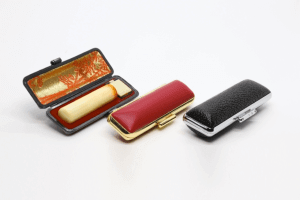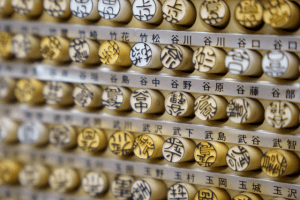Do I really need to get a hanko/inkan (personal seal for stamping documents) while I’m living in Japan?

One aspect of Japanese life that surprises many newcomers to the country is the use of hanko, personal seals, to certify or validate official documents, rather than the use of signatures as is common in most other countries (those from Korea or China will likely find the custom more familiar). But is a hanko really necessary for life in Japan if you are not Japanese? If so, how do you obtain a hanko and when should you use it?
What is a hanko (/inkan)?

First up, some terminology. The word hanko (判子) refers to the device (made of plastic, metal, wood, bone, stone, etc.) that is dipped in ink and then used to make an impression on a document. Strictly speaking, the ink impression on the paper itself is called an inkan (印鑑), but these days most Japanese people use the terms hanko and inkan interchangeably.
Hanko are almost always used to stamp ink onto paper, in contrast with company or government seals traditionally used in Western countries which are often stamped into wax or other materials. The inkan (ink impression) left behind on the document is used to certify or validate that document.
Hanko are used for a wide variety of purposes for daily life in Japan, both by individuals and on behalf of companies and other institutions. You will see cashiers using their hanko to stamp credit card receipts, delivery people asking for you to stamp delivery invoices with your hanko for confirmation that you have received your package, ward office officials using a hanko to certify official documents.
There are also different types of hanko used for different purposes in Japan, each with its own particular uses (and level of “seriousness”/security). These three types are the most likely to be relevant for foreign residents:
- mitome-in (認印) - used to verify low-security documents such as postal receipts or utility bills. Usually produces a round or oval inkan. Does not need to be officially registered. A cheaper version known as sanmonban (三文判) is also available (plastic is fine, but avoid rubber stamps as these are not generally considered acceptable).
- jitsu-in (実印) - used to validate important documents, mostly contracts involving marriage, vehicle purchases, or property purchases. The inkan must be square or rectangular (never round) and is strictly regulated by several other regulations. A jitsu-in (実印) must be officially registered at your city/ward office.
- ginko-in (銀行印) - used solely for certifying banking documents. Each bank has different regulations regarding shape, size, etc. Ginko-in (銀行印) are registered at your bank instead of your city/ward office.
Do I really need a hanko if I’m living in Japan?
It depends. Many foreign residents find that they can get by without a hanko even if they are living in the country for many years. Many of the functions that require hanko can also be performed using your signature (especially institutions used to dealing with foreign residents).
Sign carefully… Japanese institutions such as banks will often be much more diligent than banks in your home country in checking that your signature matches the signature that they have on file. It is not uncommon to be asked to rewrite your signature if it does not match exactly. Unless you are confident in the consistency of a more stylized signature that you usually use, you may wish to print or write your name carefully instead.
Whether or not you require one, two or all three of the different types of hanko (mitome-in, jitsu-in, ginko-in) depends on how long you will stay in Japan, what type of job you will do in Japan, whether you intend to buy property in Japan, and how much you want to adapt to Japanese culture and society.
Check the table below to see whether you require one, two, all three (or none) of these types of hanko while you are living in Japan.
The Three Main Types of Hanko (判子) in Japan
| mitome-in (認印) | jitsu-in (実印) | ginko-in (銀行印) | |
|---|---|---|---|
| Description | Plastic, stone, other materials. Usually leaves a round or oval inkan on the page. | Materials and shape regulated by law (varies regionally). Usually leaves a square or rectangular inkan on the page. | Materials and shape regulated by law (varies regionally). Usually leaves a square or rectangular inkan on the page. |
| Primary Use | Everyday documents | Formal contracts | Banking documents |
| Registration | Not usually required | Your city or ward office | Your bank or financial institution |
| Necessary if you want to... | ...avoid awkward situations where a hanko is expected ...follow Japanese traditions, social conventions ...experience the satisfaction and convenience of stamping documents! |
...purchase property in Japan ...purchase a vehicle in Japan ...sign a contract (e.g. a freelancer working with a Japanese company) |
....start a company in Japan NOTE: most banks in Japan will accept a signature instead of a seal from foreign residents unless you are starting a company |
Along with registering your jitsu-in or ginko-in, you will likely need to pay to have it made professionally for security reasons, as mass-produced versions are not considered secure. Mitome-in can be purchased from most stationery stores.
In recent years, the Japanese government has taken steps toward cutting down on the use of hanko and potentially eliminating the need for hanko entirely in the future, in order to reduce the necessity of so many paper documents and move toward digitization. There is support for this plan, particularly due to paper documentation reportedly causing some delays during the COVID-19 pandemic, but there is also opposition to eliminating hanko in terms of tradition, established social conventions, and reliability. Such changes tend to be gradual in modern Japan, especially with the large proportion of elderly people in the country, so it is probably safe to assume that hanko will be around for a while!
Still not sure if you’ll need a hanko or not? There’s no need to rush! The process typically takes three days or less, so if you eventually encounter a situation where you really need one, you should have more than enough time to get it done.
Where can I buy a hanko?

If you require a jitsu-in or ginko-in, you will likely need to pay to have it made professionally for security reasons, as mass-produced versions are not considered secure.
This can be done at any hanko-ya (判子屋) in Japan. Nowadays, it is possible to shop for a hanko online, but this will be next to impossible if you do not read and write Japanese. You will probably have more luck if you venture out to an actual store: either one of the many chain hanko-ya shops or to one of the small local hanko-ya that used to be found all over the country but are fast disappearing (this can be quite a memorable and worthwhile experience if you can find one!).
Avoiding ivory The legal status of elephant and mammoth ivory as a material for use and sale is still somewhat murky in Japan. While guidelines state that sales of ivory are banned in principle, there are still companies that advertise and sell ivory products. Given concerns about pressure on wild elephant populations, you may wish to avoid companies that still sell ivory hanko, such as Hankoyasan 21, one of the major hanko chains in Japan.
Mitome-in can be purchased from simple stationery stores or department stores; however, many of these may only offer common Japanese surnames or single katakana characters.
An inexpensive option if you’d like your actual name (or part of it) to appear on your hanko is Don Quijote (sometimes known semi-affectionately as “Donki”), which has a machine in some of its stores where you can choose what you want to be printed on your hanko and it will be made for you in a matter of minutes.
The fascinating history of hanko As with kanji characters, rice cultivation, and Buddhism, the practice of using official seals came to Japan from China, where ancient official seals dating back to nearly 4000 years ago have been discovered.
Use of official and personal seals began among the nobility in Japan, then spread to the dominant warrior class throughout the Sengoku period. With the establishment of the samurai class, only the samurai were permitted to use seals with red ink.
Government institutions, corporations, or noble families in Japan often possess large and ornate hanko with complex inscriptions that refer to Japanese literature or history, such as the state seal of Japan (大日本國璽).
How much does a hanko cost?
Prices vary widely based on the type of seal, where you buy it, and the materials used. Mass-produced mitome-in can be purchased very cheaply at 100 yen shops. However, these hanko are not personalized to you and your name and thus cannot be used for any official functions.
Customized cheap hanko can be made at stores like Don Quijote for as little as ¥500 and these can potentially be used for official purposes. Beyond that, the cheapest wooden seals from a hanko-ya store run around ¥2000. You can pay far more, of course, if you want a hanko made with fancy artwork or expensive materials such as silver or lacquer.
If you intend to use your hanko as a jitsu-in or ginko-in, you should ensure that it satisfies the requirements of your local city/ward office or bank. Visiting a hanko-ya might be an advantage in this case, as they will be aware of the requirements.
How do I register my hanko?
If you want to register a jitsu-in, you need to visit your local city or ward office. There will likely be a specific counter for inkan (hanko) registration (ask if you’re not sure…).
You will need:
- Your hanko
- Your residence card (or My Number card)
Just fill out a short form and make a small payment (normally around ¥50). You will then receive an inkan shomeisho registration card (印鑑登録証) that certifies your registration of your hanko/inkan.
If you want to register a ginko-in, you need to visit your bank or financial institution and follow their procedures. Some banks will allow you to do this via the mail. Contact your bank for more details. Again, a ginko-in is not really necessary for foreign residents unless you plan to start your own company.
To be used in an official capacity, your hanko/inkan must include either all or part of your name. This could be all or part of your name in the Roman alphabet (e.g. Bob, Sarah) or in katakana (e.g. ボブ、サラ).
However, if you plan to use katakana, you should ensure that your local ward or city office has a record of your name in katakana as well as the Roman alphabet.
As tempting as it might be to use a hanko featuring your favorite kanji (or cartoon character), this cannot be registered for official use as they will not match your official name on record. If all you are after is a cool souvenir, then that is up to you!
How do I use my hanko?
First, remove the cap. It will not work with the cap on...
Once you have successfully avoided that rookie mistake, tap your hanko lightly 2-3 times on the ink pad. Place the document to be stamped onto a flat even surface and press downward with a slightly clockwise motion.
Not all hanko work the same way, of course, so you could practice a few times if you want to make sure you can do it right. Just make sure to destroy the practice paper after you are finished.
Right side up? An upside down inkan is pretty embarrassing. Take a quick peek underneath first!
What happens if I lose my hanko?
Losing a hanko, particularly a registered hanko like a jitsu-in or ginko-in, should be treated similar to the loss of a piece of official identification. Your hanko/inkan can be used as your official signature, so it is important to act quickly to guard against fraud, identity theft, and similar crimes. Here’s what you need to do:
- Immediately report it lost or stolen to the police. You can simply visit your local kōban police box (交番) and they will be pleased to assist you. You may require some assistance from a Japanese speaker if you do not speak Japanese.
- Visit your local city or ward office and cancel your hanko/inkan registration.
- Buy a new hanko.
- Visit your local city or ward office again and fill out the paperwork and pay your fee for a new hanko/inkan registration.
To guard against loss or theft of your officially-registered hanko, it is best to store your official seal in a secure hidden location (not so hidden you forget where it is though!). Don’t carry it around with you in your bag or purse. It is also never really necessary to take it on trips outside Japan.
Conclusion
Overall, there is no real need for most foreign residents of Japan these days to obtain a hanko unless they are planning to sign certain types of contracts that require a jitsu-in seal. A ginko-in is only necessary if you plan to start a company in Japan (and you should discuss this with your bank anyway).
Your signature is perfectly acceptable for virtually all everyday transactions and interactions.
That said, many foreign residents find that owning a simple mitome-in can make some situations and interactions smoother and less awkward with local Japanese people, particularly in rural areas.
And there is something to be said for the actual experience of getting a hanko custom-made with your own name, an experience that makes you feel a bit more integrated as part of a tradition stretching back through centuries of Japanese history.
